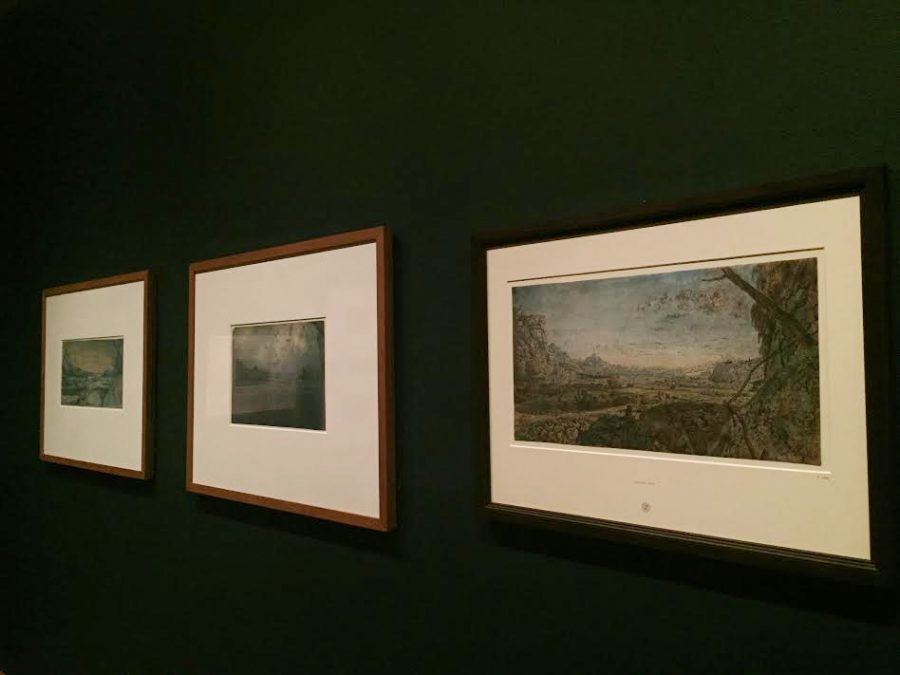Hercules Segers’ Otherworldly Beauty at the Met
Pictured is “Mountain Valley with Fenced Fields, ca. 1625-30” by painter Hercules Segers, whose work is being featured at the Metropolitan Museum of Art. This exhibit, “The Mysterious Landscapes of Hercules Segers,” includes landscapes and oil sketches.
February 17, 2017
A giant oak tree springs from the ground as branches coil in irregular turns and patches of leaves shoot up into the sky. Tiny buildings dot the city skyline as it extends into the distant view. This postcard-sized landscape is one of many in the boundless panorama of Hercules Segers’s prints. Organized in collaboration with Rijksmuseum in Amsterdam, the Metropolitan Museum of Art’s new exhibit, “The Mysterious Landscapes of Hercules Segers,” is the first of its kind in the United States devoted to Segers. It surveys a body of landscape and still-life etchings, as well as some oil sketches and paintings.
Even amateur art fans know the Dutch Golden Age master Rembrandt van Rijn, but not many have heard of Hercules Segers. Few of his works survive today — only 10 print impressions are in museums across the United States. The Met has only one in its permanent collection, and there are 74 prints at the Rijksmuseum. Rembrandt himself was an admirer of Segers’ works — he collected eight of Segers’ paintings and one printing plate. He even drew inspiration from landscapes in some of Segers’ works.
Segers came from a well-to-do merchant’s family, but he grappled with financial difficulties during his life. He eventually died in poverty. A student of the Flemish landscape master Gillis van Coninxloo, Segers journeyed to Amsterdam to train with the artist and lived there most of his life. He rarely travelled outside of the Netherlands — instead, his imagination filled the gaps in his sceneries. In “Roman Ruins,” he illustrated the ancient landmarks from imagination, building a wall from tiny, neatly arranged bricks and laying out a bed of rough, bulky rocks in the foreground.
Segers invented the lift-ground etching technique, which allowed him to outline the structure of objects like the Roman ruins with fluid strokes. Using a brush to paint directly onto the etching plate preserved his brushstrokes as he added details and a natural, unfinished touch to his shrubs and bushes surrounding the ruins. The ruins complex is fudged with patches of darker shades, contrasting with the thinner outlines of the bricks and the blank space of the sky.
The use of color also made Segers’ works stand out from those of his contemporaries. Instead of creating black-and-white etchings like artists from the 17th century, he bathed his prints in variations of colored ink to heighten the mood of the impressions. In “Mountain Valley with Fenced Fields,” Segers applied different colors to depict morning, dusk and nighttime scenes. Brighter hues shine through the clear blue sky in the daytime while spreading dark blue ink across the starless sky. In another of his prints, “Ruins of the Abbey of Rijnsburg from the South,” he etched fine lines on a dark brown background which he glossed over with dark paint. The abbey was a monument demolished in the Dutch Independence War and was a top day-trip destination in Segers’ time. Segers, a true master, was able to capture both the somber atmosphere and ghostly representation of the monument.
“The Mysterious Landscapes of Hercules Segers” will remain on view at the Metropolitan Museum of Art at 1000 Fifth Ave. through May 21. Museum admission is pay-as-you-wish.
Email Phyllis Lam at [email protected].


























































































































































